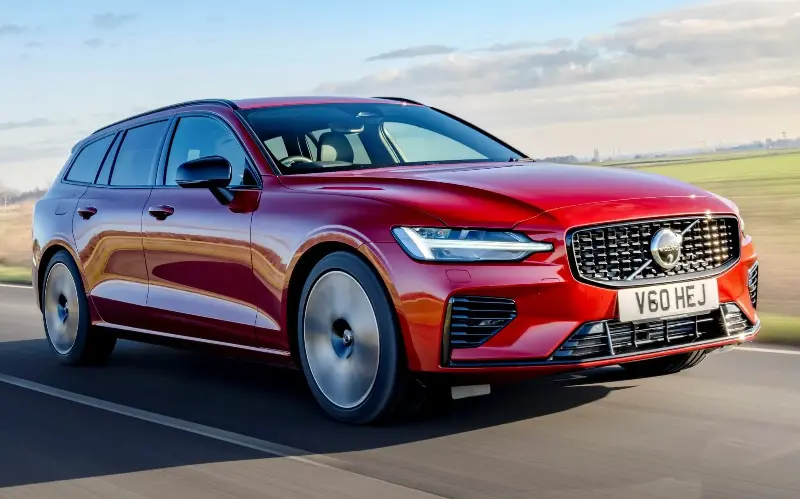
Skip to:
For a trip to Leeds on a bank holiday weekend to meet my new niece, with mum, dad, two kids and a boot full of luggage plus several boxes of baby-related detritus on board, a Volvo estate would seem ideal.
But Volvo itself wasn’t so sure last year – it reckoned British buyers preferred SUVs, so it pulled the V60 from the market, along with the larger V90.
The outcry was universal; the idea of a Volvo range without the estates upon which the company had built its reputation for safety and practicality was unthinkable. A tranche of owners swore they would rather buy another brand’s estate than switch to a Volvo SUV.
Volvo, to its credit, realised it had made a mistake. Not even a year later, it announced it was bringing back the V90 and V60 to Britain. An occasion worth celebrating?
Pros
- Smooth, quiet and refined
- Beautiful interior
- Brilliant real-world fuel economy
Cons
- Firm ride around town
- Not as big a boot as you might hope
- Not particularly engaging to drive
Limited supply
Well, don’t get too excited just yet, because while the V60 and V90 are back, the ranges are somewhat limited.
The V60 will be available with only two engine options: a 345bhp plug-in hybrid (PHEV) and a 194bhp mild hybrid. The V90 won’t get the latter engine; it is PHEV only.
The trip to Leeds was in the mild hybrid V60, the most affordable model in the newly streamlined range. These things are relative; it still starts at just shy of £44,000, which puts it directly in the line of fire of the BMW 3 Series and just below the spangly new Audi A5 Avant.
However, you get more for your money than you do with either German rival. More power, for starters, given the 3 Series is 12bhp the poorer, while the most basic A5 has only 148bhp.
You get better fuel economy, too; at almost 45mpg on the official combined cycle, the Volvo beats even the far less powerful Audi. There’s more equipment into the bargain; a heated steering wheel, windscreen, front and rear seats. In addition, a powered tailgate and an electronically adjustable driver’s seat with memory settings are standard on the entry-level V60, while the Ultra model tested has even more goodies.
Oh, and imagine my joy upon opening the boot to find a proper spare wheel. It’s a £150 optional extra, but at least it’s available, which is more than can be said for most modern cars.
Palatial surrounds
By comparison with its rivals, then, the V60 seems good value, but that doesn’t mean it feels cheap inside. Indeed, the V60 is largely unchanged from the model that last appeared in showrooms in 2023 and that’s a good thing; the plethora of lovely, high-density plastics, the rock-solid build quality and chunky switchgear that moves with reassuring sturdiness are all retained.
The standard leather seats in our car had been switched for sports seats upholstered in a thick cloth with Nappa leather inserts; a no-cost option on both Plus and pricier Ultra versions and one I’d recommend as it brings even more warmth to this delightful interior.
Volvo’s trademark portrait touchscreen once seemed pretty large, but the vast counterparts in most of its rivals now dwarf it, which means it can sometimes feel a little fiddly to operate.
For all that, it responds quickly, and while you do have to resort to the screen for the climate controls, the fact there’s an always-on touch bar along the bottom of the screen means you don’t have to delve into the menus to make adjustments.
Is it spacious? If you’re familiar with Volvo estates of old, you might be disappointed. The back seats are more than adequate, but the Volkswagen Passat and Skoda Superb estates offer considerably more leg room. On the plus side, the wide, square door aperture means leaning in to buckle child seats is easier than in some more rakish rivals.
In the boot, the story is the same: 519 litres isn’t vast in the grand scheme of things; antiques dealers will probably choose the VW and Skoda, with their 690-litre load bays, in preference.
Inner space
Having said that, there’s more load volume than in the Audi or the BMW, or for that matter the Mercedes-Benz C-Class estate. What’s more, the space is square and useful, while Volvo’s well-designed flip-up divider prevents smaller items flying around.
The reason why people love Volvo estates soon becomes clear: even with its large wheels, this V60 melts the miles away. The ride quality at motorway speeds is gloriously unruffled. Wind and tyre noise are miniscule, while the seats do an excellent job of providing support in all the right places.
The 2.0-litre engine with mild hybrid electrical assistance isn’t actually that slow, but it feels it sometimes; there’s a slight lack of get-up-and-go at lower revs, which together with the keening engine note further up the rev range means it never feels as quick as its power figures suggest.
There’s enough urge for everyday driving though. What’s more, the gearbox shifts smoothly and the mild hybrid component is incredibly well integrated, so the engine cuts out seamlessly when coasting. On long downhill stretches, I found myself looking at the rev counter to see if it was running or not, otherwise I simply couldn’t tell.
Fuel for thought
All that coasting really makes a difference to the fuel economy. On one leg, with the cruise control set to 70, the V60 was notching up an easy 46mpg. That was with the whole family on board, too – later in the week, solo, it was touching 50mpg on some stretches. Not bad for a near-200bhp petrol-engined estate.
What’s it like off the motorway? Well, the ride isn’t quite as composed at urban speeds; unfortunately, the large wheels and slender tyre sidewalls get caught in potholes, which send a shudder through the car. It’s not intolerable, but there are smoother-riding alternatives.
As you might imagine, this Volvo isn’t particularly captivating to hustle along a B-road, but that’s not its purpose. There’s not much feedback through the steering, which feels over-assisted. On the plus side, the nose changes direction curtly and there’s very little in the way of body lean, so in an emergency it will look after you.
As, indeed, it would have if the worst were to happen. With adult and child protection scores of 96 and 84 per cent respectively in crash tests, the V60 seems to live up to Volvo’s reputation for safety. All of which simply added to my peace of mind on a lengthy family trip.
The Telegraph verdict
The reincarnated V60 still isn’t as sporty or as posh as some of its rivals, but its blend of pragmatism, comfort and Scandinavian “hygge” makes it a preferred option when you have a family to shift half way up the country and back again.
Most of its rivals now are newer, shinier and spanglier. But as a family hauler with a touch of class, the V60 is still surprisingly hard to beat. Grab one before Volvo changes its mind again.
Telegraph rating: Four stars out of five
The facts
On test: Volvo V60 B4 Ultra
Body style: five-door estate
On sale: now
How much? £45,890 on the road (range from £43,940)
How fast? 112mph, 0-62mph in 7.6sec
How economical? 44.8mpg (WLTP Combined)
Engine & gearbox: 1,969cc four-cylinder petrol engine, seven-speed dual-clutch automatic gearbox, front-wheel drive
Electric powertrain: 48V integrated starter-generator motor with 0.45kWh battery
Electric-only range: 0 miles
Maximum power/torque: 194bhp/221lb ft
CO2 emissions: 143g/km (WLTP Combined)
VED: £540 first year, £620 next five years, then £195
Warranty: 3 years / 60,000 miles
Spare wheel as standard: no (optional extra)
The rivals
BMW 320i M Sport
184bhp, 41.5mpg, £45,180 on the road
For decades, the go-to choice for a mid-sized, sporty-ish family hauler with a premium badge. The 3 Series Touring still is, in many ways, although the ride in M Sport form is even firmer than the Volvo’s. The boot is smaller and you get less for your money, yet the BMW delivers the sort of incisive handling of which the Volvo driver can only dream.
Audi A5 1.5 TFSI 150 Sport Avant
148bhp, 41.7mpg, £45,285 on the road
Audi’s new A5 – think of it as a replacement for the A4, in yet another confusing naming decision – is a sharp-suited customer, with rakish lines that make the Volvo look like one of its bolt-upright ancestors. But of course the swish styling means space is at a premium, particularly in the boot – the Volvo is a more pragmatic, more comfortable, choice. Better value, too, with so much more power, better fuel economy and a plethora of extra equipment for only £500-odd more.
Volkswagen Passat 2.0 TSI 204 R-Line
201bhp, 40.4mpg, £47,715 on the road
The venerable Passat is still on sale, but the range is reduced to a rump, with no saloons or diesels; a smattering of petrol and plug-in hybrid models is the only choice. This top-flight model has all the bells and whistles and a potent petrol turbo engine that makes it surprisingly good fun; it’s vast inside, while standard adaptive suspension makes it even more comfortable than the Volvo. But, despite all that space, the price is hard to justify, while the fuel economy is only middling as it’s not a mild hybrid.
